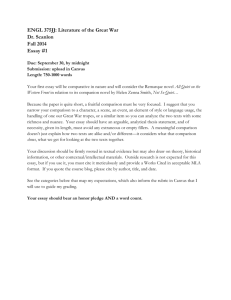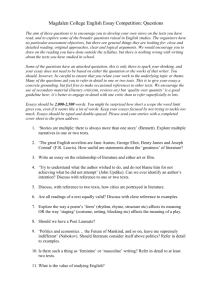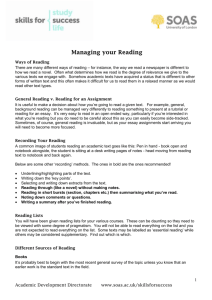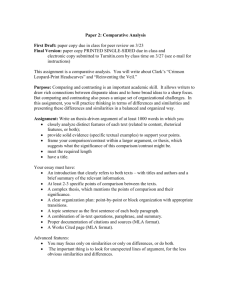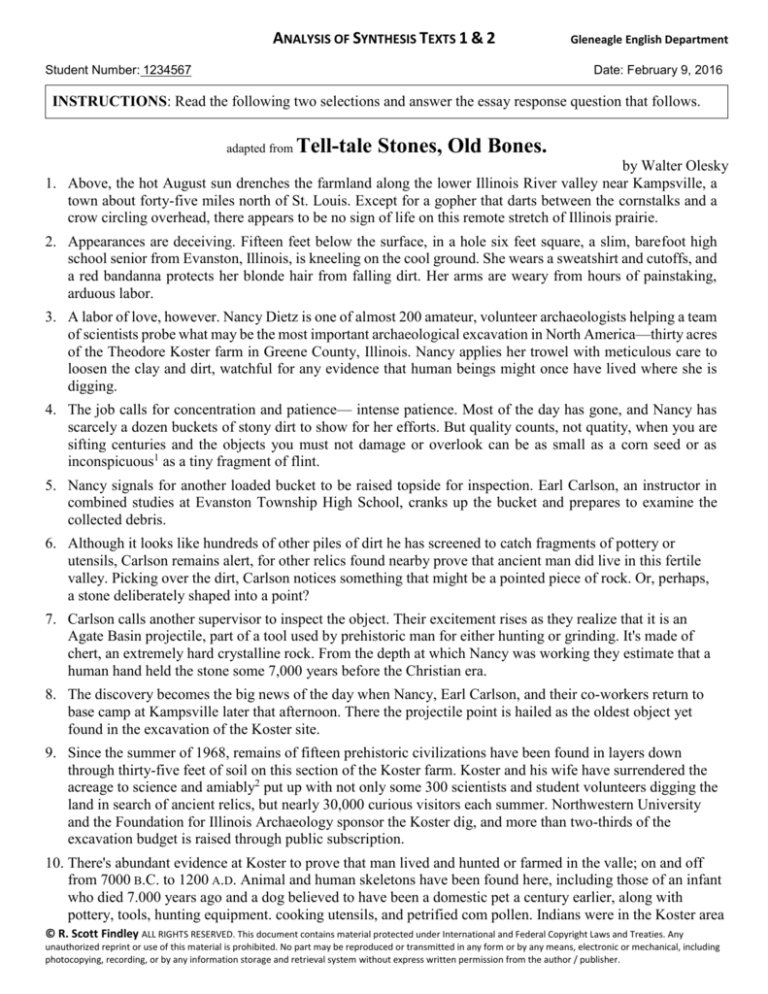
ANALYSIS OF SYNTHESIS TEXTS 1 & 2
Student Number: 1234567
Gleneagle English Department
Date: February 9, 2016
INSTRUCTIONS: Read the following two selections and answer the essay response question that follows.
adapted from
Tell-tale Stones, Old Bones.
by Walter Olesky
1. Above, the hot August sun drenches the farmland along the lower Illinois River valley near Kampsville, a
town about forty-five miles north of St. Louis. Except for a gopher that darts between the cornstalks and a
crow circling overhead, there appears to be no sign of life on this remote stretch of Illinois prairie.
2. Appearances are deceiving. Fifteen feet below the surface, in a hole six feet square, a slim, barefoot high
school senior from Evanston, Illinois, is kneeling on the cool ground. She wears a sweatshirt and cutoffs, and
a red bandanna protects her blonde hair from falling dirt. Her arms are weary from hours of painstaking,
arduous labor.
3. A labor of love, however. Nancy Dietz is one of almost 200 amateur, volunteer archaeologists helping a team
of scientists probe what may be the most important archaeological excavation in North America—thirty acres
of the Theodore Koster farm in Greene County, Illinois. Nancy applies her trowel with meticulous care to
loosen the clay and dirt, watchful for any evidence that human beings might once have lived where she is
digging.
4. The job calls for concentration and patience— intense patience. Most of the day has gone, and Nancy has
scarcely a dozen buckets of stony dirt to show for her efforts. But quality counts, not quatity, when you are
sifting centuries and the objects you must not damage or overlook can be as small as a corn seed or as
inconspicuous1 as a tiny fragment of flint.
5. Nancy signals for another loaded bucket to be raised topside for inspection. Earl Carlson, an instructor in
combined studies at Evanston Township High School, cranks up the bucket and prepares to examine the
collected debris.
6. Although it looks like hundreds of other piles of dirt he has screened to catch fragments of pottery or
utensils, Carlson remains alert, for other relics found nearby prove that ancient man did live in this fertile
valley. Picking over the dirt, Carlson notices something that might be a pointed piece of rock. Or, perhaps,
a stone deliberately shaped into a point?
7. Carlson calls another supervisor to inspect the object. Their excitement rises as they realize that it is an
Agate Basin projectile, part of a tool used by prehistoric man for either hunting or grinding. It's made of
chert, an extremely hard crystalline rock. From the depth at which Nancy was working they estimate that a
human hand held the stone some 7,000 years before the Christian era.
8. The discovery becomes the big news of the day when Nancy, Earl Carlson, and their co-workers return to
base camp at Kampsville later that afternoon. There the projectile point is hailed as the oldest object yet
found in the excavation of the Koster site.
9. Since the summer of 1968, remains of fifteen prehistoric civilizations have been found in layers down
through thirty-five feet of soil on this section of the Koster farm. Koster and his wife have surrendered the
acreage to science and amiably2 put up with not only some 300 scientists and student volunteers digging the
land in search of ancient relics, but nearly 30,000 curious visitors each summer. Northwestern University
and the Foundation for Illinois Archaeology sponsor the Koster dig, and more than two-thirds of the
excavation budget is raised through public subscription.
10. There's abundant evidence at Koster to prove that man lived and hunted or farmed in the valle; on and off
from 7000 B.C. to 1200 A.D. Animal and human skeletons have been found here, including those of an infant
who died 7.000 years ago and a dog believed to have been a domestic pet a century earlier, along with
pottery, tools, hunting equipment. cooking utensils, and petrified com pollen. Indians were in the Koster area
© R. Scott Findley ALL RIGHTS RESERVED. This document contains material protected under International and Federal Copyright Laws and Treaties. Any
unauthorized reprint or use of this material is prohibited. No part may be reproduced or transmitted in any form or by any means, electronic or mechanical, including
photocopying, recording, or by any information storage and retrieval system without express written permission from the author / publisher.
ANALYSIS OF SYNTHESIS TEXTS 1 & 2
long before Druids raised the Stonehenge monoliths (1800 B.C.) or slave labor constructed the Egyptian
pyramids (3000 B.C.).
11. Even more important to archaeologists than Nancy's ancient chert point was the discovery of remnants of
four permanent dwellings containing hearths3 and storage pits. It is estimated that the structures, the earliest
habitations yet discovered in North America, were occupied by prehistoric man more than 6,000 years ago.
Found at a depth of thirty-four feet, they have caused much discussion.
12. "The discovery that Indians living in Illinois more than 6,000 years ago were sophisticated enough to alter
the landscape and put up substantial structures changes some of our ideas about early man," says Dr. Stuart
Struever, a professor of anthropology and archaeology at Northwestern University and director of the
excavation activities.
13. "We used to think that permanent villages and a sedentary4 life only came about after people had developed
agriculture," Struever explains. "But in the lower Illinois valley agriculture did not become a way of life
until several hundred years after the birth of Christ. These ancient houses were built by people who relied
on a hunting and gathering economy."
14. Unpaid, uncomfortable labor, digging for the bones and relics of people long dead, is hardly orthodox5
activity for a youthful generation often described as selfish and hedonistic.6 What draws these particular
young people to it?
15. "I volunteered to dig at Koster last summer because a friend who dug there the year before told me it was
exciting," Nancy Dietz explains. "It was hard work but exciting, too. Especially when I sent up that bucket
with the chert projectile."
16. Mary Etzkorn, from Chicago, completed her sophomore year at Mundelein College, then decided to take a
vacation from classroom work and volunteered to dig in the fields at Koster last summer. When she arrived
in early June, the valley and Kampsville were practically buried under mud from heavy spring rains. She
joined the others in cleaning up the site and the houses and laboratories in town.
17. "Ever since I was a kid, I wanted to be an archaeologist," says Mary. "I figured that you learn best by doing
something, so I quit college for a year. I came to Koster partly to see if I could hack the hard work. I learned
that 1 could take it."
18. Dr. Struever looks somewhat deeper for the reason why working at Koster appeals to the young people.
"They're naturally restless," he says, "and I believe archaeology helps them to develop deep ground roots.
Working with their hands, digging in the ground, unearthing the mysteries of past civilizations seems to give
them a sense of continuity. Their world is threatened by war and the Bomb. On the Koster farm, they come
to realize that ancient man had to face equally devastating7 threats to his civilization, from warfare on a very
personal level to famine, predatory8 animals, and natural disasters such as floods and the Ice Age."
19. His usually animated face grows more still and serious. He adds, "The fifteen civilizations which settled at
various times in the Illinois River valley prove that man endures. New life comes back. And for
archaeologists and young adventurers alike, it's almost too incredible to believe that such rich prehistory is
buried so close to home. Not in Egypt, but right here in Southern Illinois."
______________________________________________
1.
2.
3.
4.
5.
6.
7.
8.
inconspicuous: attracting little or no attention
amiably: in a friendly manner
hearths: stone or brick floors of fireplaces
sedentary: settled; not migratory
orthodox: usual; customary
hedonistic: pleasure-seeking
devastating: destructive
predatory: living by preying on others
Adapted from “Tell-tale Stones, Old Bones” by Walter Olesky. Reprinted from Marathon World,
published by Marathon Oil Company.
2 of 6
© R. Scott Findley
ANALYSIS OF SYNTHESIS TEXTS 1 & 2
adapted from
Canyon
by Don Gayton
1. I had a ritual for my visits to that deep and narrow canyon. At the end of the walk up from the ranch, I would
stop short of the mouth to wait and collect a few sticks for the fire. After a few moments I would enter,
crossing from plangent1 afternoon sun to a kind of separate and constant dusk. The canyon’s layered rock
walls would glow with a faint bluish tinge.
2. Buck Creek starts somewhere above treeline and flows through the canyon all the way down to sagebrush.
Originally the creek ran parallel to the main river, but sometime in the distant Pleistocene2 it turned abruptly,
confronting a massive sandstone ridge that separated the two. The result of that unrecorded confrontation was
a narrow, vertical canyon cut through bedded sandstone, and a contented Buck, now joined with its central
drainage. Whatever violence had accompanied the creation of this tiny canyon was resolved in total peace.
Even during spring flood the Buck flowed like silk down its smooth and rounded bed.
3. As a dusty young hired man on an Okanagan ranch, this canyon and its water provided retreat and solace at
the end of the long workday. After my token wait at the entrance, I would move to the first pool. My work
clothes, sticky with hay dust and sweat, would go into a neat pile on the first ledge, next to the sagebrush
sticks I had collected. Only then did I slide quietly into the water, to float on my back and look upward. The
west wall of this pool was a series of ledges leading up to a sheer sandstone face; the east wall formed a
broad, curved overhang, reminiscent of a church nave. Halfway up the west wall a scrappy ponderosa pine
had established itself on a ledge. It presided over the canyon, a modest icon.
4. After a few minutes in the first pool I would climb the narrow sandstone spillway to the second pool, float
for a time, then go to the third and finally the fourth. Sometimes I felt suspended, as if I were floating
through the rooms of a fantastic sculpture gallery, each one a different statement of colour, texture and form.
5. After my swim, I would return to the ledge of the first pool to build a tiny fire from the gnarled and twisted
sagebrush sticks and drink from a canteen. Pungent sage smoke would curl straight upward on its way out of
the windless canyon.
6. The rancher I worked for was an old man in those days and is long since dead. At the time I saw him only as
a kind of grim coordinator of cattle, grass and barbwire, but later on I realized he must have known of the
very personal, mystical nature of the canyon. That would explain his casual, welltimed remark about “those
pools on the Buck, up above Bigsage Pasture,” for the benefit of one he must have known would seek them
out and then promptly deny anyone else’s presence there. Certainly it was not long before the water of that
canyon flowed only for me.
7. For years I thought about revisiting the place. In my experience of natural landscapes, the canyon stood out
in my memory as one of the more openly spiritual places, rising above the level of simple nostalgia. Buck
Creek was prominent on my itinerary for re-exploration.
8. It was the potato chip, balanced on the first ledge like some obscenely alien butterfly, that first caught my
eye. The chip, a nearby paper plate and several large, garish graffiti now lay strewn across a personal tapestry
of my own memory, one that had lain inviolate3 for twenty-five years. The graffiti were spray painted in
orange Dayglo on the sandstone overhang of the first pool. “FERG95” and “TORCHY,” they screamed.
There were a few other initials as well; “B.D.” was one. The authors would be high school graduates frantic
to enhance personal identities by hijacking the spirit of the place.
9. My long-awaited reunion with the canyon destroyed, I stopped only long enough to survey the litter and the
damage. A cold wind passed through my guts and I felt as if I had come home to a break-in. I left cleanly,
not wanting to waste time in useless rage.
3 of 6
© R. Scott Findley
ANALYSIS OF SYNTHESIS TEXTS 1 & 2
10. I was well into the long, furious walk back down through the pasture when anger finally gave way to duty
and to the service of memory.
11. First I built a fire on the rock ledge, reversing the old ritual, and immolated the potato chip, the plate and
some bits of candy wrapper. Then I stripped, waded into the first pool, took a handful of gritty sand from the
bottom, and began to scrub the graffiti off the sandstone wall. It was slow work. A handful of sand would last
only a few strokes before slipping through my fingers.
12. Parts of the sandstone were deeply stained by the paint. I scraped those areas with the sharp edge of a stone
and then feathered the slight depressions back by scrubbing with more sand. It seemed appropriate to remove
the graffiti from this place with primitive technology.
13. The very fragility of the sandstone was an asset to my work. I was able to scrape deeply enough into the
body of the wall that I could get beyond the paint’s deepest penetration. I could train my memory to accept
change, since change is a dynamic of nature, but I would never let it accept degradation.4
14. When the wall was finally finished, I returned to the ledge and dressed. This time, my clothes had none of
that fine old stink of hay, sweat and horses. They could still, I mused, if I had stayed on. I could even have
guarded this place on grad nights.
15. As I left, I took a last look up the canyon. The ponderosa pine up on the west wall had prospered, and the
place was clean again. Fresh sandstone was evident on the overhang, but no paint could be seen, and I had
scrubbed broadly enough that even the shapes of the letters could no longer be made out. I hoped that a few
years of weathering would bring the entire wall back to its original grainy blue-white, and memory would
then be served.
______________________________________________
1.
2.
3.
4.
plangent: a deep colour
Pleistocene: a geological time period beginning approximately one million years ago
inviolate: intact, unspoiled
degradation: dishonour
Adapted from “Canyon” by Don Gayton, Landscapes of the Interior published by New Society
Publishers (1996), p. 23–26.
4 of 6
© R. Scott Findley
ANALYSIS OF SYNTHESIS TEXTS 1 & 2
INSTRUCTIONS: In a multi-paragraph (3 or more paragraphs) expository essay of at least 300 words,
answer the question below in the Response area. Use the Organization and Planning
space to plan your work. The mark for your answer will be based on the appropriateness
of the examples you use as well as the adequacy of your explanation & the quality of
your written expression.
1. Discuss how the narrative voice in “Canyon” would react to the archaeological dig described in “Tell-tale
Stones, Old Bones.”
Put Your Title Here
Type your paragraph here.
5 of 6
© R. Scott Findley
ANALYSIS OF SYNTHESIS TEXTS 1 & 2
SCORING GUIDE FOR ANALYSIS OF SYNTHESIS TEXTS 1 AND 2
This is a first-draft response and should be assessed as such.
The response is assessed holistically.
6
The six essay is superior, demonstrating an insightful understanding of the texts. The essay shows a
sophisticated approach to synthesis, including pertinent references. The writing style is effective and
demonstrates skillful control of language. Despite its clarity and precision, the essay need not be error-free.
5
The five essay is proficient, demonstrating a clear understanding of the texts at an interpretive level.
The essay clearly synthesizes the concepts within the texts. References may be explicit or implicit and
convincingly support the analysis. The writing is well organized and reflects a strong command of the
conventions of language. Errors may be present, but are not distracting.
4
The four essay is competent. Understanding of the texts tends to be literal and superficial. Some synthesis
is apparent. The essay may rely heavily on paraphrasing. References are present and appropriate, but may be
limited. The writing is organized and straightforward. Conventions of language are usually followed, but
some errors are evident.
3
The three essay is barely adequate. Understanding of the texts may be partially flawed. An attempt at
synthesis is evident. References to the texts are not clearly connected to a central idea or may be repetitive.
The response may be somewhat underdeveloped. A sense of purpose may be evident, but errors can be
distracting.
2
The two essay is inadequate. While there is an attempt to address the topic, understanding of the texts or
the task may be seriously flawed. An essay that makes reference to both texts but refers only fleetingly to
one of them is inadequate. The response may be seriously underdeveloped. Errors are recurring, distracting,
and impede meaning.
1
The one essay is unacceptable. Although the essay mentions both texts, the essay is too brief to address the
topic or there may be a complete lack of control in the writing.
0
The zero essay reflects a complete misunderstanding of the texts and/or the task, or is a restatement of the
question. Exclusive reference to only one text does not constitute synthesis. Exclusively narrative responses
reflect a complete misunderstanding of the task.
*Any zero paper must be cleared by the section leader.
NR
A blank paper with no response given.
6 of 6
© R. Scott Findley


